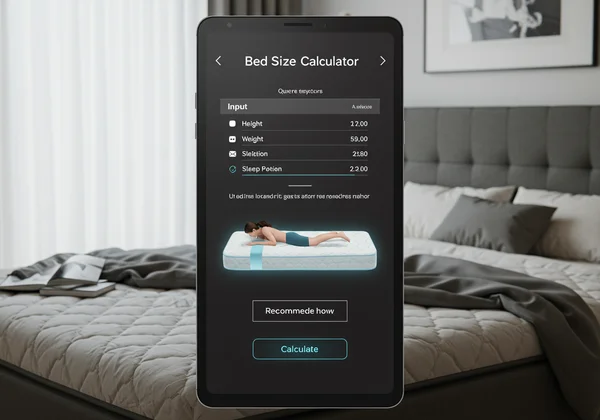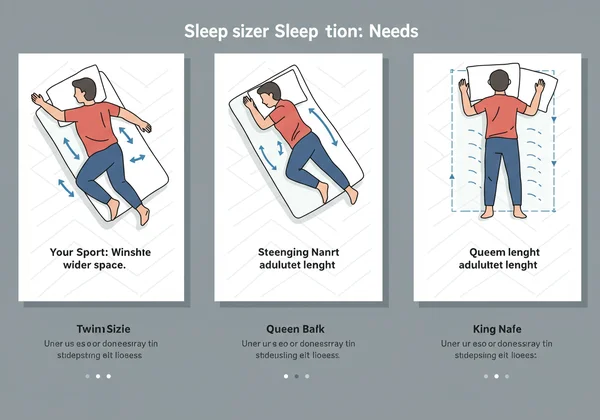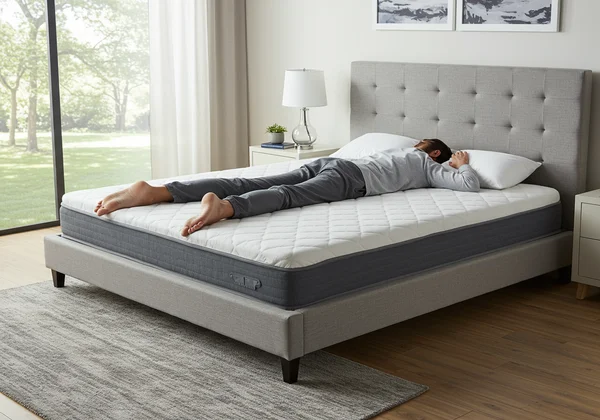Bed Size Calculator Logic: Sleep Position & Body Type
Have you ever stood in a mattress store feeling completely overwhelmed? It’s a common experience. Choosing the perfect bed size often feels like guesswork, but what if there was a smarter way? Our intelligent tool moves beyond simple charts to provide a personalized recommendation based on science-backed principles. What size bed should I get? This guide pulls back the curtain on our bed size calculator logic, revealing exactly how your unique sleep habits and body type dictate the ideal mattress dimensions for you.
Forget one-size-fits-all advice. The perfect night's sleep starts with a foundation built for you. By understanding the data points that matter most—from the way you curl up at night to your height—you can make an informed decision with confidence. Let's explore the "why" behind our recommendations and empower you to find the perfect fit. Ready to decode your sleep needs? You can get your recommendation right away.

Understanding Mattress Size for Sleep Position
The way you sleep is one of the most significant factors in determining your spatial needs. Ever wonder why a mattress feels different for a back sleeper versus a side sleeper? It's all about your 'sleep footprint'. This intelligent system analyzes your preferred sleep position to ensure you have ample room to rest comfortably and naturally without feeling confined.
Side Sleepers: Why Width is Your Ally
Side sleeping is the most common position, but it also takes up the most horizontal space. When you sleep on your side, your knees are bent and your arms are often outstretched. A narrow mattress, like a Twin, can leave you feeling like you're teetering on the edge. This is why the recommendation engine prioritizes width for side sleepers. A Full, Queen, or King mattress provides the necessary space to accommodate your natural posture, preventing your limbs from hanging off the bed and ensuring your spine remains aligned. For couples where one or both are side sleepers, a King size bed often becomes the default recommendation for optimal comfort.
Back & Stomach Sleepers: The Importance of Length and Support
Back and stomach sleepers tend to lie flatter, which means they don't require as much width as side sleepers. However, length is crucial. Your feet should never dangle off the end of the mattress, as this can strain your ankles and lower back. The system cross-references your height with standard mattress lengths to ensure a proper fit. For anyone over 6 feet tall (183 cm), a standard Queen may feel short. You'll likely be guided toward a Twin XL, California King, or other longer variants to provide complete body support from head to toe.
Active Sleepers & Couples: Minimizing Disturbance with More Space
Do you toss and turn throughout the night? If so, you're an "active sleeper." For solo active sleepers, a bed that’s one size larger than standard recommendations (e.g., a Full instead of a Twin) can make a world of difference. When you add a partner to the mix, space becomes non-negotiable. The recommendation engine heavily weighs the "Number of Sleepers" input, especially if you indicate sensitivity to partner movement. A Queen size bed is often the minimum for couples, but for active sleepers, a King provides a personal "no-disturbance" zone, drastically improving sleep quality for both individuals.

Bed Size by Body Type: Height & Weight's Influence
Your physical characteristics are the second pillar of our recommendation engine. A mattress is an ergonomic product, and its dimensions must correspond to your body's size and shape to provide true comfort and support. It analyzes height and weight to ensure the bed is not just a place to sleep, but a space that promotes restorative rest.
For Tall Sleepers: Unpacking Twin XL and California King
Being tall has its advantages, but finding a comfortable bed isn't always one of them. Our database contains specific solutions for taller individuals, a group often overlooked by generic size charts. If you're over 6'2" (188 cm), our bed size by body type logic immediately flags standard-length beds as unsuitable. It will guide you toward options like the Twin XL, which adds 5 inches of length to a standard Twin, or the California King, which is 4 inches longer than a standard King. This ensures you can stretch out fully without your feet touching the footboard. You can discover your perfect size with our specialized calculator.
Weight Distribution: How It Affects Comfort and Mattress Longevity
Weight is a critical factor not just for mattress firmness, but also for dimensions. A heavier individual or a couple will compress a mattress more, which can make the available surface area feel smaller. Adequate space is essential for proper weight distribution, which in turn reduces pressure points and prevents premature sagging. The tool considers total weight to recommend a surface area that provides durable, long-lasting support. For two adults, this often reinforces the need for a Queen or King, ensuring the mattress structure isn't overtaxed and that both sleepers have sufficient room to rest without "rolling into" the middle.

The Logic Behind Our Bed Size Calculator
So, how does it all come together? Our tool isn't just a simple filter; it's a recommendation engine that synthesizes multiple data points to create a personalized profile of your sleep needs. It balances competing factors to arrive at the most logical conclusion for your unique situation.
Inputs Explained: Height, Weight, & Number of Sleepers
These are the foundational inputs. The process starts here to establish a baseline.
- Height primarily dictates the required length of the mattress.
- Weight informs the necessary surface area for support and comfort.
- Number of Sleepers determines the minimum required width.
For instance, a 6'4" solo sleeper will be guided towards a California King, whereas a 5'5" couple will be pointed towards a Queen or King, depending on other preferences. This powerful system processes these inputs in seconds; try our intelligent tool to see it in action.
Beyond the Basics: Bedroom Size & Personal Preferences
A perfect bed is useless if it doesn't fit in your room. The calculator includes an input for bedroom size to provide practical, realistic recommendations. It ensures there's enough space for walkways and other furniture. Furthermore, we account for personal preferences. Do you like to spread out like a starfish? Do you share your bed with pets or children? These qualitative inputs help fine-tune the recommendation, nudging you towards a larger size if you value expansive space over a minimalist bedroom layout. This comprehensive approach is what makes the results from our bed size calculator so reliable.

Empower Your Sleep: Trusting Data for Your Ideal Bed Size
Ready to choose your bed size with confidence? Let data be your guide, not guesswork. By understanding how your sleep position, body type, and room dimensions come together, you can move past generic advice and find a solution tailored just for you. Your journey to years of quality, restorative sleep begins now. Let's find your perfect foundation together.
Don't leave your comfort to chance. Take a few moments to answer a few simple questions in our intelligent recommendation tool. We'll handle the complex calculations so you can focus on what truly matters: achieving deep, restorative sleep every single night. Find your ideal fit on our homepage today.
Frequently Asked Questions About Choosing Your Bed Size
What size bed should I get if I'm a tall single sleeper?
For tall single sleepers, length is the top priority. We typically recommend a Twin XL (80 inches long) for those who need a narrow bed for a smaller room, or a California King (84 inches long) if you desire more width and have the space. Both options prevent the common issue of feet hanging off the end of the bed.
Is a full bed big enough for two people who are active sleepers?
A Full bed is generally not recommended for two adults, especially if either is an active sleeper. At 54 inches wide, it provides only 27 inches of personal space per person—the same as a crib. For couples, a Queen is the recommended minimum, but for active sleepers, a King size bed is the best bed for side sleepers and movers, as it provides maximum personal space and minimizes partner disturbance.
How does my preferred sleep position really impact the recommended mattress size?
Your sleep position determines your "sleep footprint." Side sleepers require more width to accommodate bent knees and arms. Back and stomach sleepers need sufficient length. The recommendation engine uses this information to ensure the bed's dimensions match your natural sleeping posture, preventing you from feeling cramped or unsupported.
How Does Our Tool Calculate My Ideal Mattress Size?
Our recommendation engine uses a multi-factor algorithm. It analyzes your height, weight, sleep position, number of sleepers, and bedroom size. It cross-references these inputs against a comprehensive database of mattress dimensions and ergonomic principles to generate a personalized recommendation. It’s a data-driven approach designed to provide the most accurate and helpful advice, and you can try our free tool to get your personalized result in seconds.